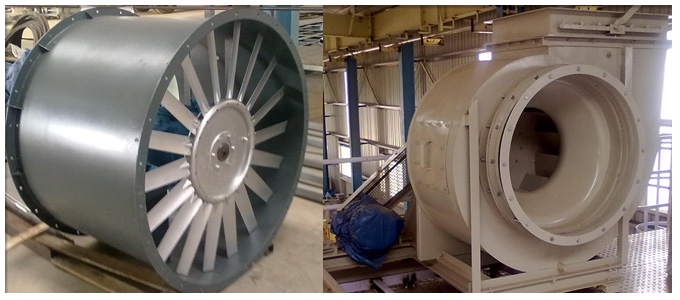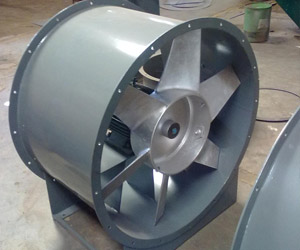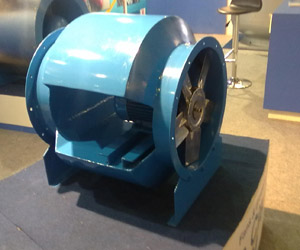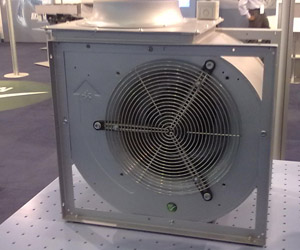Axial Fans and Centrifugal Blowers

Axial Fans
 A fan is a device that is designed to move a specific volume of air (flow) against moderate pressure (resistance). A fan induces an airflow by virtue of its blades; a blade moves air by generating a lift force when in motion through the air. An axial flow fan is a fan in which the flow of air is substantially parallel to the axis of rotation.
A fan is a device that is designed to move a specific volume of air (flow) against moderate pressure (resistance). A fan induces an airflow by virtue of its blades; a blade moves air by generating a lift force when in motion through the air. An axial flow fan is a fan in which the flow of air is substantially parallel to the axis of rotation.
The three main kinds of axial fans are-
• Propeller fans - These fans are used to move large quantities of air against very low static pressures. They are usually used for general ventilation or dilution ventilation and are good in developing up to 0.5 in. wg
• Tube-axial fans - Tube-axial fans are similar to propeller fans except they are mounted in a tube or cylinder. Therefore, they are more efficient than propeller fans and can develop up to 3 to 4 in. wg). They are best suited for moving air containing substances such as condensable fumes or pigments.
• Vane-axial fans - Vane-axial fans are similar to tube-axial fans except air-straightening vanes are installed on the suction or discharge side of the rotor. They are easily adapted to multistage and can develop static pressures as high as 14 to 16 in. wg. They are normally used for clean air only.
Special Futures:
- Low vibrations as per VDI 2056.
- Aerodynamic Performance tested as per BS 848 Part-1 (1980)
- Sound Performance tested as per BS 848 Part-2 1985.
Bifurcated Fans
 The Bifurcated fans having cast Aluminum alloy impeller, aero foil section blade with MS Casing. This fan is mostly placed to exhaust or supply the air of corrosive nature or hazardous for the motor. In this the motor is not the stream of air, this remain protected from the particles available in the air.
The Bifurcated fans having cast Aluminum alloy impeller, aero foil section blade with MS Casing. This fan is mostly placed to exhaust or supply the air of corrosive nature or hazardous for the motor. In this the motor is not the stream of air, this remain protected from the particles available in the air.
Centrifugal Blowers
 Centrifugal fans consist of a wheel or a rotor mounted on a shaft that rotates in a scroll-shaped housing. Air enters at the eye of the rotor, makes a right-angle turn, and is forced through the blades of the rotor by centrifugal force into the scroll-shaped housing. The centrifugal force imparts static pressure to the air. The diverging shape of the scroll also converts a portion of the velocity pressure into static pressure.
Centrifugal fans consist of a wheel or a rotor mounted on a shaft that rotates in a scroll-shaped housing. Air enters at the eye of the rotor, makes a right-angle turn, and is forced through the blades of the rotor by centrifugal force into the scroll-shaped housing. The centrifugal force imparts static pressure to the air. The diverging shape of the scroll also converts a portion of the velocity pressure into static pressure.
There are three main types of centrifugal fans:
• Radial blade fans - Radial-blade fans are used for heavy dust loads. Their straight, radial blades do not get clogged with material, and they withstand considerable abrasion. These fans have medium tip speeds and medium noise factors.
• Backward curved blade fans - Backward-blade fans operate at higher tip speeds and thus are more efficient. Since material may build up on the blades, these fans should be used after a dust collector. Although they are noisier than radial-blade fans, backward-blade fans are commonly used for large-volume dust collection systems because of their higher efficiency.
• Forward curved blade fans - These fans have curved blades that are tipped in the direction of rotation. They have low space requirements, low tip speeds, and a low noise factor. They are usually used against low to moderate static pressures.
Special Futures guarantee high performance and reliability:
- Dynamically balanced as per VDE 2060
- Vibration within limits as per VDI 2056
- Aerodynamic Performance as per IS/BS/AMCA standards





